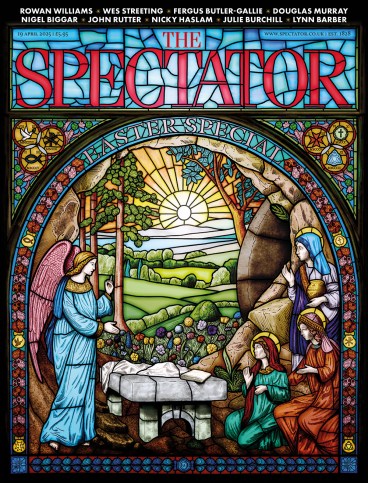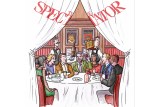
Rhinoceros by Eugene Ionesco is a period piece from 1959. It opens with the invasion of a French village by a herd of rhinoceroses. This paranormal event is never explained. In Act Two, the villagers start to imagine that they’ve become rhinoceroses and changed species. But one plucky sceptic, who defies conformity, refuses to swap his human character for an animal alternative. That’s it. Ionesco is offering the same arguments about peer-group pressure that Arthur Miller made with far more grace, artistry and psychological penetration in The Crucible.
The show can’t decide what register to aim for and the cast are dressed in a mishmash of cheap costumes. Some wear white coats like asylum orderlies and some are in Primark expendables. Many of them scream or honk out their lines in grating voices. Ionesco’s script adds to the noise and confusion.
The show begins with a compère who warms up the crowd by doing arm-stretching exercises, as if the Almeida were a care-home for dribbling old crocks. Then the play begins and the main characters, Bérenger and Jean, meet in the village café. Ionesco has no interest in human beings and his characters are as absorbing as teddy bears or plastic flowers. And the surreal storyline moves at the pace of smog.
These faults are concealed by arrival of several prattling commentators, who discuss Jean and Bérenger using a pastiche of the pretentious chitchat favoured by academics. The play keeps switching focus from the events on stage to a literary analysis of those events, and back again. Audacious in 1959, perhaps. Not any more.
A third layer of narrative complication is added. Beside the playing area stand two tables equipped with microphones and pieces of kitchen clutter which the actors use to produce sound effects, as if the play were being recorded for the radio. Lots of directors employ this gimmick and it usually reveals the same problems: a lack of confidence in the script and deep misgivings about the show’s viability as a spectacle. Theatre means seeing, not listening, and a director who moves from the visual to the acoustic realm is having an artistic crisis on stage.
The result is a futile, dated and mirthless pastiche. It’s like watching a two-hour radio sketch discarded by Spike Milligan because it wasn’t funny enough. A note of caution. The crowd adored this show, and at the curtain call they screamed and whooped like maniacs. Could it be a hit? Let’s not rule it out.
Thanks For Having Me is a new comedy about hook-up culture. If you’re single, affluent and living in London, here’s how it works. Sex is your friend. Love is your enemy. A fling is physical but never emotional.
It’s like watching a two-hour radio sketch discarded by Spike Milligan because it wasn’t funny enough
You can assemble a large harem of partners but you have to keep your distance. Never share breakfast with a lover and don’t even kiss them goodbye at the front door. On no account visit a farmers’ market together and buy organic yoghurt and fruit juice. That’s how you end up in a relationship. And hook-up culture is a revolt against long-term commitment. Both women and men can enjoy transactional sex on equal terms and this play follows the lives of three busy bed-hoppers.
But Cashel is different. He’s a sensitive, vulnerable fool who secretly longs for a steady girlfriend and a wife. Schooled by his wiser and more experienced flatmate, he tries to play the field and to conduct an arm’s-length affair with Eloise, a slinky blonde bombshell. On their first date, Cashel falls instantly in love. ‘When she took off her top, I wanted to blind myself so it was the last thing I ever saw.’ Eloise discovers that Cashel is struggling to suppress his real feelings and she finds his confused adoration profoundly attractive.
So both of them are now breaking the rules. Meanwhile Cashel’s flatmate finds himself falling in love with his regular no-strings partner, too.
The development of the story is a bit predictable, and a cynic may argue that the show lacks dramatic weight. Perhaps it’s just a 90-minute sitcom. Well, so what? The pacy script has vast reserves of wit, swagger and style. So does the chic, fleet-footed production.
The supporting cast led by Nell Tiger Free are fabulously funny. The show is written by the lead actor, Keelan Kember (Cashel), who happens to look like a movie star. Comparisons between him and Hugh Grant may be exaggerated but not by much. As a writer of light comedy he bears comparison with Simon Gray and the young Christopher Hampton.
His collaborators are the director, Monica Cox, and the producer, Kit Bromovsky. Their names will become significant in our theatre. What a joy this show is. A sophisticated and intelligent feelgood comedy that speaks the truth about love, sex and romance.










Comments